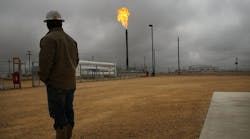Latest from Economic Data
Electrical Marketing - December 20, 2024
Electrical Marketing's Key Economic Indicators
Natural Gas & Renewables Dominate Power Producers’ New Construction & Proposals
It may not come as a surprise that the trend in the fuel sources powering new generating facilities is moving quickly away coal and toward natural gas and renewables. But the move may be happening faster than you expected.
According to the Edison Electric Institute, Washington, D.C., as of last year natural gas has surpassed coal as the largest part of the nation’s fuel mix for the first time ever, accounting for 34%. Coal is now at 30.4%, followed by nuclear (19.7%); hydroelectric power (6.5%); non-hydro renewables (8.3%); fuel oil (0.6%); and other (0.5%). Over the past 10 years, coal has dropped -18.6%, while natural gas increased 13.9% and non-hydro renewables increased nearly 6%.
And consider some public data collected annually by the Energy Information Administration (EIA) about the new generating facilities now being built electric utilities and independent power producers (IPPs) or on the drawing boards. EIA says that from 2016 through 2023 only six new power plants utilizing conventional steam coal and producing a total of 1,689 MW are underway, and that they will only account for 1.4% of the 122,036 total megawatts being produced by these new projects from 2016 to 2023.
As you can see in the chart, new generating plants powered by natural gas-fired combined cycle technology dominate the list of new projects, with 193 plants producing 56,041MW for 45.9% of the total. Onshore wind turbines are expected to produce 24,597 MW, 20.2% of the total, and 565 solar projects will produce 14,522MW for 11.9% of the total.
It’s interesting to note that while electric utilities still account for the majority of the new generation coming online, some large companies are getting in on the actions, too. Apple, Archer Daniels Midland, BJ’s Wholesale Club, Formosa Plastics, Georgia-Pacific, Merck and Sierra Nevada Brewing Co. also want to produce their own power and have projects either underway or planned. There’s some activity in the nuclear sector, with the Georgia Power and South Carolina Electric & Gas Co. working toward activating 1,000MW nuclear reactors in 2019 and 2016 and a 1,269MW Tennessee Valley Authority facility that came online in Rhea County, TN, in Oct. 2016.
Twenty-nine of the projects in the EIA database are 500MW or larger and 404 are at least 100MW or larger. In another sign of the dearth of construction of large coal plants, with the exception of an currently delayed 850MW conventional steam coal plant that Power4Georgians LLC is hoping to bring online by 2022 in Washington County, GA, none of the coal plants in the EIA database are 100MW or larger.
With 3,000MW coming online from 2019-2023, the Chokecherry and Sierra Madrea wind farm being built by the Power Company of Wyoming, a subsidiary of the privately Anschutz Corp., Denver, is the largest wind project now underway right now and one of the largest electric generating projects of any sort. The $5 billion multi-phase installation will include up to 1,000 wind turbines and is being built 50% on private land and 50% on public land, according to www.powercompanyofwyoming.com. The Anschutz Corp. is an example of the diversity of companies now build electric generation projects in that it’s a privately held company with a diverse array of businesses, including ranching, agriculture, energy development and distribution.
On the solar side, the 485MW Blythe Mesa Solar Power Project in Riverside County, CA, is the largest photovoltaic project currently being built in the United States. When the multi-phase project is completed by 2020, it will produce enough electricity to power more than 145,000 California homes.
Other renewable projects of note include nine geothermal installations that are expected to come online over the next five years that will produce a combine total of 472MW and 138MW of power that started to come online from 16 battery projects.












